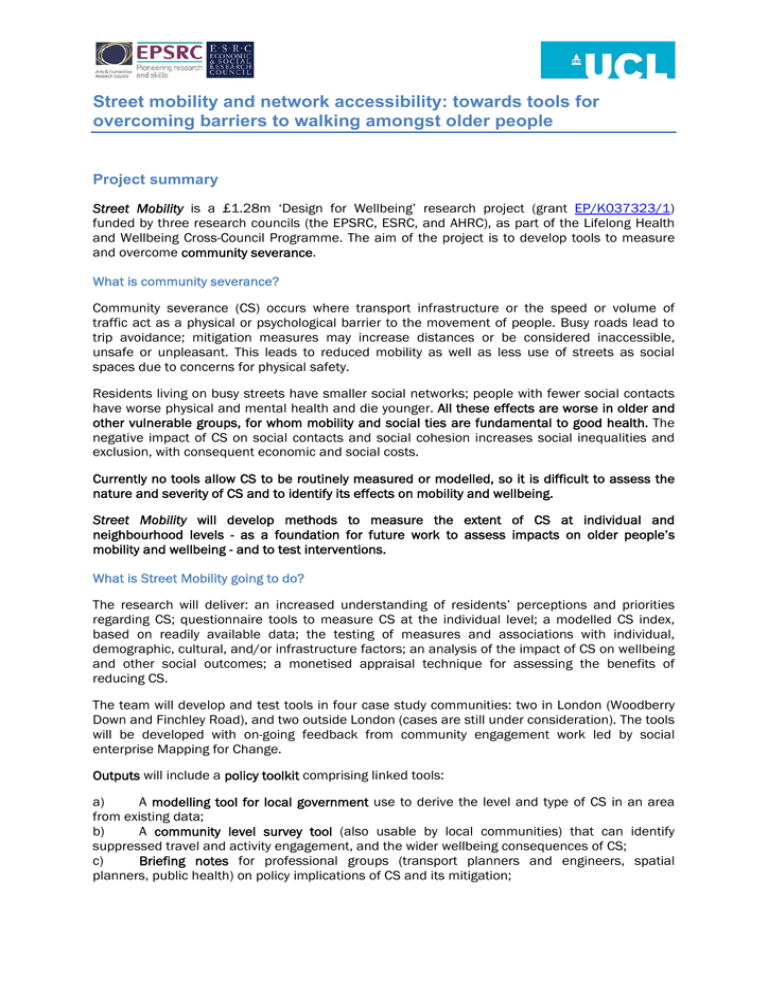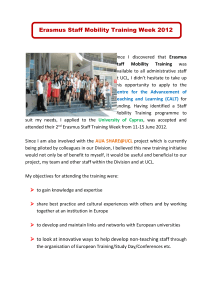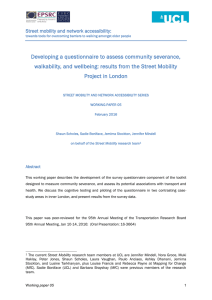Street mobility and network accessibility: towards tools for
advertisement

Street mobility and network accessibility: towards tools for overcoming barriers to walking amongst older people Project summary Street Mobility is a £1.28m ‘Design for Wellbeing’ research project (grant EP/K037323/1) funded by three research councils (the EPSRC, ESRC, and AHRC), as part of the Lifelong Health and Wellbeing Cross-Council Programme. The aim of the project is to develop tools to measure and overcome community severance. What is community severance? Community severance (CS) occurs where transport infrastructure or the speed or volume of traffic act as a physical or psychological barrier to the movement of people. Busy roads lead to trip avoidance; mitigation measures may increase distances or be considered inaccessible, unsafe or unpleasant. This leads to reduced mobility as well as less use of streets as social spaces due to concerns for physical safety. Residents living on busy streets have smaller social networks; people with fewer social contacts have worse physical and mental health and die younger. All these effects are worse in older and other vulnerable groups, for whom mobility and social ties are fundamental to good health. The negative impact of CS on social contacts and social cohesion increases social inequalities and exclusion, with consequent economic and social costs. Currently no tools allow CS to be routinely measured or modelled, so it is difficult to assess the nature and severity of CS and to identify its effects on mobility and wellbeing. Street Mobility will develop methods to measure the extent of CS at individual and neighbourhood levels - as a foundation for future work to assess impacts on older people’s mobility and wellbeing - and to test interventions. What is Street Mobility going to do? The research will deliver: an increased understanding of residents’ perceptions and priorities regarding CS; questionnaire tools to measure CS at the individual level; a modelled CS index, based on readily available data; the testing of measures and associations with individual, demographic, cultural, and/or infrastructure factors; an analysis of the impact of CS on wellbeing and other social outcomes; a monetised appraisal technique for assessing the benefits of reducing CS. The team will develop and test tools in four case study communities: two in London (Woodberry Down and Finchley Road), and two outside London (cases are still under consideration). The tools will be developed with on-going feedback from community engagement work led by social enterprise Mapping for Change. Outputs will include a policy toolkit comprising linked tools: a) A modelling tool for local government use to derive the level and type of CS in an area from existing data; b) A community level survey tool (also usable by local communities) that can identify suppressed travel and activity engagement, and the wider wellbeing consequences of CS; c) Briefing notes for professional groups (transport planners and engineers, spatial planners, public health) on policy implications of CS and its mitigation; d) Valuation of improvements to CS using ‘stated preference’ surveys and ‘willingness to pay’ data for assessment of policy options This toolkit will enable cross-sector policy development and appraisal, allowing the creation of a common language and set of issues that can then be shared between policy makers and community leaders. Street Mobility will fill a gap in academic knowledge, offering a cross-disciplinary evidence-based approach to studying community severance (CS). Increasing understanding of the built environment’s influence on older users’ activity and mobility is also of wider strategic importance. Our findings will have implications for urban design and spatial planning locally, nationally and internationally. Street Mobility will be valuable to policy makers, practitioners and local communities themselves. It focuses on making people's lives better and offers local communities tools to engage with professionals about the forms and consequences of CS that impact adversely on their lives. This study will bring to policy makers’ attention the forms of CS, their impacts on people's lives, and the mitigations that can be used. Interventions that reduce CS and increase mobility and activity will help maintain older people’s independence, reducing health and social care costs, and facilitate access to local goods, enhancing the local economy. The study will identify 'willingness to pay' to reduce severance and the knock-on cross sector benefits of improved wellbeing and physical and mental health. Our proposed user impact plan will ensure that findings are disseminated across the many users in the UK and internationally, using our extensive experience in disseminating research through traditional routes and also novel means including public-facing articles and reports, mass-media and new web-based communication (including social media), and workshops for policy-makers and planners nationally run jointly with local communities. We will invite residents from the case study areas to participate in dissemination activities alongside other local stakeholders. Where possible we will build capacity amongst end users for long-lasting impact. The research is led by a multi-disciplinary team at University College London (UCL) from the Faculty of Engineering Science, the Faculty of Population Health Sciences, and the Faculty of the Built Environment. The study team comprises experts in transport engineering and policy, scheme appraisal, geography, urban design, space syntax, epidemiology, public health, anthropology, community engagement, statistics and modelling, as follows: Dr Jennifer Mindell; Professor Peter Jones; Professor Laura Vaughan; Professor Nora Groce; Professor Muki Haklay; Dr Shepley Orr; Dr Shaun Scholes. Three researchers are working on the project: Dr Sadie Boniface, Dr Ashley Dhanani, and Dr Paulo Anciaes. Key stakeholders in the project include local authority elected members and spatial planning, transport and public health staff, the voluntary sector, and community members in the case study areas. Relevance to end-users will be ensured by their and project partners’ involvement throughout, from concept to final use. The project’s Advisory Group includes stakeholders across the policy, community, academic, public and voluntary sectors. It will play an important role in ensuring meaningful impact takes place. Project partners include national third sector and professional organisations to add value by providing expertise on the topic and aid wide dissemination. For more information: Visit our website: http://www.ucl.ac.uk/street-mobility Visit our blog: http://www.streetmobility.wordpress.com Follow us on Twitter: @StreetMobility Email Dr Jennifer Mindell (Principal Investigator): j.mindell@ucl.ac.uk



